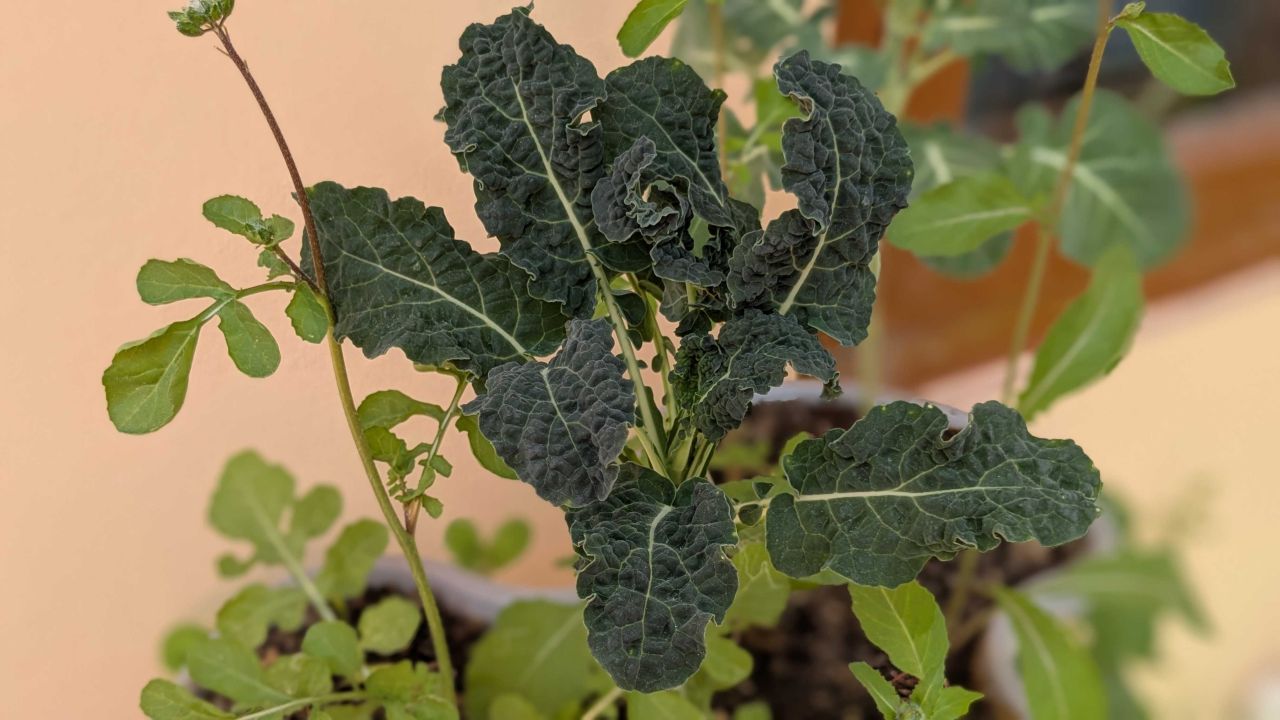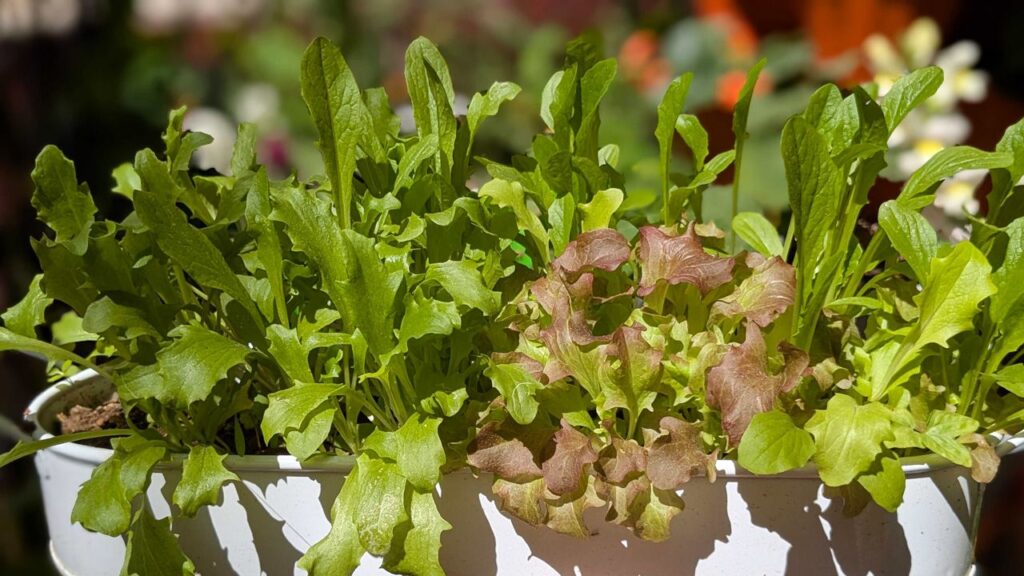There is nothing more fruitful than growing your produce (pun intended). Whether you have an outdoor space or not, you can grow fresh farm-to-table produce at home and it gets easier if you are keen on growing salad ingredients. Despite the available space, you can build your spring salad garden in late March or early April, depending on your zone, and have platefuls of lush greens by May.
So how to build a spring salad garden, you ask? Well, it is really simple. You will need a space, whether it is a large and expansive garden, or a small balcony or patio.
I grow salad greens on my 15×3-foot balcony, which receives about 3-4 hours of sunlight daily, depending on the season. If you don’t want to dabble with that sort of thing, it doesn’t need any building or construction. Grab some seeds, and fill some pots with three parts native soil, one part compost, and a little bit of sun. In no time, these seeds will sprout, so you can have fresh greens on your plate all season long.
Though it may sound rather easy (and it is), you do need to consider a few things. Let’s talk in detail.
Also Read: Spring Gardening Tips: Ten Essentials You Wish You Knew Earlier
What to Plant in a Salad Garden
What you plant in your salad garden comes down to individual preferences. Some people enjoy sweet, fruit-filled salads, while others (like me) enjoy the savory versions more. I rarely enjoy fruit in my salad, except for roasted pear or roasted peach; it needs a delicate balance of leafy greens, potatoes, beans, meats, pickled onions, or a little bit of seasonal variety. So I plant seeds keeping my taste and preference in mind.
While your garden will mirror your choices of ingredients on your plate, there are a few staples you should have. This will require you to plant certain things in your salad garden: Don’t worry, even a child can grow these ingredients they are so easy.
Leafy Greens
Leafy greens serve as a base of almost every salad, therefore, making them a worthy contender for your garden space. But that isn’t to say that your options are limited. You get to choose from a plethora of leafy greens such as spinach, kale, arugula, lettuce, and much more. For a high-quality, nutritious salad, ensure that you grow a blend of greens and mix them in your bowl of nutrition for an appealing display of color and texture.

Microgreens
Even though I am not a very big fan of microgreens, I cannot deny that they are a powerhouse of nutrients. Moreover, they are incredibly easy to grow and don’t need much space either. For the uninitiated, microgreens are edible plants that are harvested when they are finger-long (with just the stem and first leaves). They are fast-growing and denser with nutrients than mature plants. You grow microgreens from a vast variety of seeds including broccoli, mustard, herbs like basil and oregano, radish, watercress, spinach, beets, sunflowers, and so on.
Vegetables
Vegetables are a staple in most salads. You can never go wrong with tomatoes, cucumbers, and peppers, and all of them are easy to grow in pots and containers, eliminating the need for a big garden space. If you are lucky enough to have a considerable garden, you are at liberty to grow whatever vegetable you like, including root vegetables like radishes, carrots, kohlrabi, beets, and turnips. These vegetables are great to add some color and texture to your salad.
Fruits
Even if all-fruit salads are not your thing, adding a few slices of fruit gives the salad a nice sweet and tangy flavor. You need not think of growing big fruit trees for this either. Small vining and bush fruit plants such as strawberries, blueberries, raspberries, and blackberries are your ideal options if space constraint is your issue. If you have space to grow trees, try planting apples, peaches, and pears, and soon sweet, juicy treats will make amazing and nutritious additions to your plate.
Herbs
Not a vital ingredient, but herbs add the perfect finishing touch to any salad. The best, however, is that they are incredibly easy to grow and adapt to garden beds and containers alike. Fresh herbs like basil, dill, mint, and parsley add fragrance and flavor to the salads. Regardless of the space availability, you should consider planting a variety of herbs to prepare your salads according to your taste preferences.
How to Build a Salad Garden
Salads are year-round, therefore, you need to plan your garden accordingly. However, leafy greens will always be in season and they can grow from January to December with a little bit of planning. For beginners, lettuce is a great first crop as its shallow roots and compact size do as well in containers as in the ground. Now here are the tips on how to build your salad garden, regardless of the available space.
Choose the Site
A salad garden thrives in full to part sun, making it favorable to grow in the ground or containers. If you don’t have access to a garden, you can grow leafy greens in containers and place them on the balcony or near a sunny window. When growing salad ingredients in containers, ensure to drill a few drainage holes to keep the plants from dying.
Select the Seed Mix
For beginners, lettuce seeds are a great initiation, but lettuce comes in a wide variety and it bodes well to plant a mix of these seeds. Here are my favorite seed mixes that often make rounds on my balcony salad garden.

- A Lettuce Mix: This lettuce variety pack includes eight different lettuce types with over 1,200 seeds
- Salad Greens Mix: This pack of 15 salad greens has to be my favorite. It offers over 7500 Non-GMO heirloom seeds so your garden can be packed with leafy greens all year long
- Cherry Belle Radish: I love this radish variety because it is cute as a button and can be ready to harvest in as little as 20 days. They have a crunchy mild flavor, perfect for salads
- A Pea Blend: A pea blend with easy-to-grow peas like snow peas or sugar snap can be a great addition to your salad bowl. Granted, you will need a slightly larger space to grow peas efficiently than a small balcony will provide, or you can choose dwarf varieties that don’t require stakes or trellis
- Leafy Greens Blend: When I first started, this one was my go-to seed mix. It has kale, spinach, arugula, and two lettuce types, all of which are fairly easy to grow and taste amazing
- Microgreens: For microgreen lovers, this is the best seed pack that includes 10 plants – arugula, broccoli, radish, pea, sunflower, alfalfa, cabbage, buckwheat, kale, and beets
- Power Greens: If you don’t want lettuce on your plate, this amazing blend of power greens can be your second-best alternative. The pack of five includes spinach, arugula, kale, mustard greens, and rainbow Swiss chard
Gather the Supplies
- Seeds: You can’t grow a salad garden without high-quality seeds so pick the best and keep them at hand before getting to work
- Compost: Whether you are planting in the ground or containers, high-quality compost is vital for healthy soil and hence, healthy crop yield
- Essential Tools: You will need a digging fork, garden trowel or digging knife, and water can or garden hose with sprinkling head attachment to help you with your gardening journey
- Salad Spinner and Scissors: For harvesting, you can pinch or clip the salad leaves using a pair of scissors and wash and spin them in a salad spinner
Prepare the Soil
Once you have sorted which seeds you are going to plant, it is time to prepare the soil. If you are planting in the garden, just rake out the space and add a little amount of compost. If you are planting in containers, mix three-part native soil with one-part compost and add to the containers.
Plant the Seeds
Now it is time to plant the seeds. Set them at the depth that is recommended on your seed packet. Small seeds like lettuce and radish don’t need to be sown too deep, you can simply sprinkle fine layer of soil on top of these seeds, and pat the soil firmly and water. If you sow the seeds too deep, they will struggle to germinate and ultimately die. After planting the seeds, keep the soil consistently moist until germination but don’t overwater.
Thin the Seedlings
Once the seeds have germinated and reached a height of 4-5 inches and have a couple of leaves, it is time to thin them out. Thinning the seedlings is a necessary step to ensure that plants have a required distance between them so they can have enough room to mature and draw nutrients from the soil. Whatever seedlings you thin out, they can be added to your plate.
Also Read: 10 Best Automated Indoor Gardens to Buy in 2025
Sow Successive Crops
I learned this through some trial and error. When I first planted my salad garden, I did not plan for successive crops. Once my current crop died back, I had to start anew and was left without any fresh salad greens for some time. Here is what you can do to prevent this situation: Once you start harvesting from your current crop, start the process from the beginning on the side. This way, you will always have a backup garden growing, ready to harvest in time when your primary setup reaches the end of its life.
Watering Consistency
The watering needs of your salad garden depend on the placement of the system. If your garden is in full sun, it may require daily watering compared to a part sun or shaded setup. My balcony garden, which gets 3-4 hours of direct sunlight needs water every other day, whereas the plants I have near a sunlit window need water twice a week. The watering needs of plants in containers will also vary from those planted in the ground. So keep in mind that when the top of the soil gets dried up or your plants look wilted, it is time to water.
Harvest Early and Often
The best part about a salad garden is that if you harvest smartly and often, your plant can keep on producing season-long. I have two kale plants that I planted last year. They are in small containers and if I harvest frequently, they keep on putting on leaves. As a thumb of rule, don’t cut out the entire plant when harvesting, whether it is lettuce, kale, chard, arugula, or lettuce. Take a pair of scissors, and cut the outermost leaves, leaving the center to put out more leaves.
Plant Now and Enjoy Till Fall
If you don’t live in a very hot climate, you can start your salad garden right now or even in early April and it will keep on producing till fall. However, if you live in a hot zone, your plants will start producing seeds in the heat of the summer, toward late May and June. You can replant some of these crops in late July or August, whereas crops like peas don’t do well in fall.
Note: Don’t be afraid of bolting plants (when leafy greens start to flower) as they will put out seed pods, from where you can harvest fresh seeds to be planted in the next year.
Now that you know how to build your salad garden, don’t wait around. Get to it and enjoy fresh greens year-long and refreshing platefuls of homegrown salads. You can pair the salads with a my quick dressing made from blitzing olive oil, lemon zest, and juice, mustard, cilantro, and mint. Let me know what your favorite salad ingredients are and how you prepare them. Happy gardening!
Follow Homecrux on Google News!





What a fantastic guide to building a spring salad garden! As an urban gardener with limited space, I especially appreciated your creative suggestions for container-friendly greens like arugula and baby kale. The companion planting tips (like pairing radishes with lettuce to maximize space) were genius – I’d never considered that before. Your harvest timing chart is going straight to my gardening binder! One question: For those of us in cooler climates (Zone 5), would you recommend starting any of these indoors before last frost? Thanks for putting together such a visually appealing and practical resource – you’ve inspired me to transform my balcony into a salad bar this season!
Hi Daisy. Thank you for words of appreciation. That means a lot. I am glad that this article is helpful.
Yes, for Zone 5, you should consider starting the seeds indoor around March and early April. As a good rule of the thumb, check your last frost date and start your seeds 6-8 weeks before the last frost.
But in any case, you should be able to grow a beautiful salad garden right on your balcony. Happy growing and keep reading Homecrux.